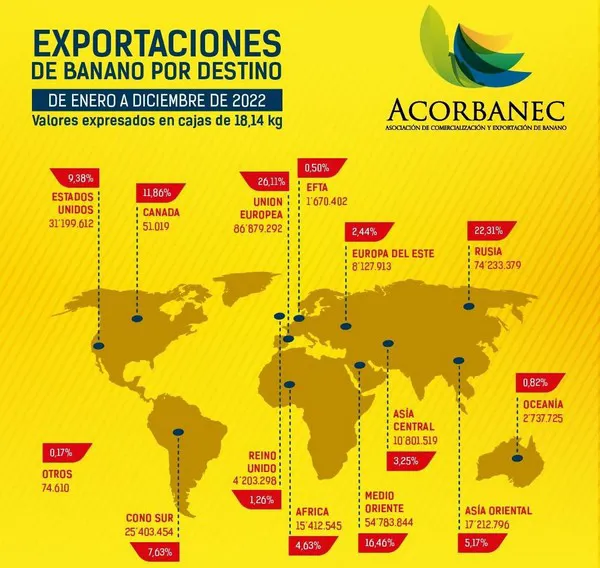From January to December 2022, Ecuador's total banana exports stood at 332.79 million boxes, down 12.16% compared to 2021.
26.11% of the exported fruit went to the European Union (-15.36%); 22.31% to Russia (-2.17%); 16.46% to the Middle East (+4.26%); 9.38% to the United States (-17.66%); 7.63% to the Southern Cone (-2.25%); 5.17% to East Asia (-14.46%); 4.63% to Africa (-40.76%); 3.25% was exported to Central Asia (+30.94%); 2.44% to Eastern Europe (-57.57%); 1.26% was exported to the United Kingdom (-13.39%); 0.82% (-20.04%) to Oceania (New Zealand); 0.50% (-6.89%) to EFTA (Norway); 0.02% to Canada (-41.56%); and 0.02% to other markets.

As explained by Acorbanec, the reduction in exports is due to different causes, including the increase in production costs, lower international demand, the Russian conflict with Ukraine (which led to oversupply in the rest of the markets) or the global inflationary context; to which we must add the impact of climatological factors.
"In Ecuador there is less fruit compared to the last 3 years. For the next 12 weeks, the falling production trend is expected to continue, and the prospects is that this will have an impact on the fruit stocks in the early part of 2023."
Acorbanec's report says that "while it is true that the minimum temperature this year has not been as low as in 2021, the maximum temperature has not been very high, and this affects the fruit's sizing and ripening."
Production projection for the first four months of 2023
In January, the banana production is expected to drop by 8.10%, which will result in 2.9 million fewer boxes compared to 2022, with 8.2 million boxes per week.
In February, there will be a 5.29% drop (1.8 million fewer boxes than in 2022), with an estimated 8.2 million boxes per week.
In March, the decline in the production will reach 5.53% (1.7 million fewer boxes), with the prospect of obtaining 5.7 million boxes per week.
Lastly, in April, the year-on-year drop in the production is expected to reach 4.01% (2.7 million fewer cases), with a projected 7.9 million boxes per week.










